
The first wave of the digital revolution in the financial world was undoubtedly cryptocurrencies. Today, however, investors’ attention is increasingly shifting beyond traditional coins and tokens. The new generation of digital assets brings with it phenomena such as NFTs and the tokenization of physical assets from the real world. Ultimately, these trends suggest that digital assets have evolved into something that goes beyond the concept of an alternative form of money.
What exactly are digital assets?
A digital asset can be simply described as any property whose ownership is recorded in digital form, typically through blockchain. Unlike cryptocurrencies, whose goal is to function as a means of payment, new digital assets represent ownership rights to real or unique digital objects – from works of art to luxury real estate. Their advantages include transparency, liquidity, and the ability to divide ownership into smaller parts, thereby opening the door to small investors who would otherwise be unable to access traditional markets such as real estate or art.
NFT
Non-Fungible Tokens (NFTs) were synonymous with the digital craze back in 2021, when artists, celebrities, and technology enthusiasts sold digital images for millions.[1] After the initial euphoria, however, the market slowed down, allowing it to mature. Today, NFTs are not used only for art but also as ownership certificates, access tokens, or digital identities. Luxury brands use NFTs to verify the authenticity of goods, game developers replace traditional licenses with them, and some technology companies are testing their use in logistics and supply chains.[2]
Tokenization
An even more interesting trend is the tokenization of real-world assets (RWA). This is the process by which ownership of a physical asset, such as real estate, a work of art, or an expensive wine, is divided into digital tokens. An investor can thus purchase, for example, a fraction of a luxury property – all through blockchain. Tokens represent a legal claim to a share of the asset or its revenue, while the entire system enables instant transfer, lower fees, and global accessibility. According to the Boston Consulting Group, by 2030, the tokenization of real-world assets could exceed USD 16 trillion, making tokenization one of the largest investment trends.[3]
Regulatory challenges
For long-term investors, this represents a promising opportunity to diversify their portfolios beyond traditional asset classes, as certain digital assets are largely uncorrelated with the stock market, making them an interesting form of protection against economic fluctuations. However, it is important to add in conclusion that every new market also brings risks. Although blockchain technology ensures transparency, the regulatory environment remains inconsistent. Many countries are still determining how to legally define this type of ownership and how to protect it against fraud.
[1] https://www.solveo.co/post/what-are-nfts-and-whats-all-the-hype-in-2021
[2] https://www.techtarget.com/whatis/feature/5-business-use-cases-for-NFTs
[3] https://cointelegraph.com/news/tokenization-of-illiquid-assets-to-reach-16t-by-2030-report

He has been trading in the capital markets since 2002, when he started as a commodity Futures trader. Gradually he shifted his focus to equity markets, where he worked for many years with securities traders in Slovakia and the Czech Republic. He also has trading experience in markets focused on leveraged products such as Forex and CFDs, and his current new challenge is cryptocurrency trading.


